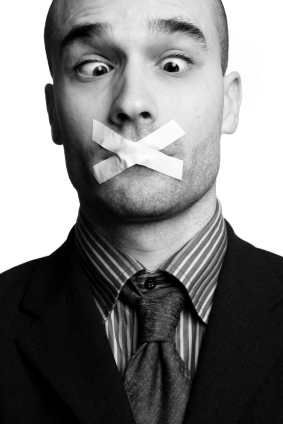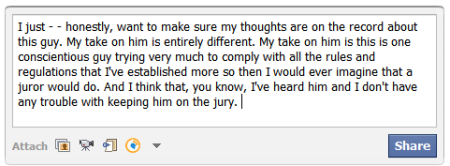Who knew 140 characters, a few status messages, and tags could play a big role in a court opinion hitting juror misconduct?
It is not a huge surprise in a criminal case involving politics, money and fraud.
A Little Background: The Criminal Case against the Defendants
 Multiple Defendants were charged with 141 counts of the following:
Multiple Defendants were charged with 141 counts of the following:
(1) Fraud and conspiracy to defraud the Pennsylvania Senate;
(2) Fraud and conspiracy to defraud Citizens Alliance for Better Neighborhoods (“Citizens Alliance”);
(3) Conspiracy to defraud the United States Internal Revenue Service (“IRS”);
(4) Fraud related to the Independence Seaport Museum (“ISM”); and
(5) Obstruction of justice and conspiracy to obstruct justice. United States v. Fumo, 2009 U.S. Dist. LEXIS 51581 (E.D. Pa. June 17, 2009)
To keep things interesting, one Defendant was a Pennsylvania State Senator.
The “Honorable” Senator was found guilty of 137 of the 139 charges against him.
Don’t Tweet the Trial
 The Defendants claimed they were entitled to a new trial because one juror had Facebook status messages and Twitter “Tweets” during the trial. Fumo, 184-185.
The Defendants claimed they were entitled to a new trial because one juror had Facebook status messages and Twitter “Tweets” during the trial. Fumo, 184-185.
Here is the short version of what happened:
One of the jurors worked in the HR department of a law firm. Fumo,192. He also was a user of Facebook, Twitter and had a personal blog.
Like many Web 2.0 savvy users, he would post status messages and “Tweets” about his day. These included messages about the trial, provided you knew what the juror was talking about, since he did not disclose any facts.
Jury deliberations were under full steam…and a TV story ran on the trial on March 15, 2009. Fumo,183-184.
The Defendants learned from the news report that one juror made online postings about the trial. The Juror also saw the headline for the report and quickly deleted his Facebook and Twitter postings out of fear. Fumo,183-184.
The Defendants in turn immediately filed a motion alerting the Court to disqualify the juror. Fumo,184.
Just What Did the Juror Say?
Twitter Postings
The juror’s one Twitter posting was simply: “This is it … no looking back now!” Fumo, 193-194.
Facebook Postings
 Below is the Court’s summary of the Facebook Status Messages:
Below is the Court’s summary of the Facebook Status Messages:
Sept. 18, 2008 (apparently upon continuance of trial judge due to judge’s illness): “… is glad he got a 5 week reprieve, but could use the money …”
Jan. 11, 2009 (apparently referring to the end of the government’s case): “… is wondering if this could be the week to end Part 1?”
Jan. 21, 2009: “…wonders if today will really be the end of Part 1???”
Mar. 4, 2009 (conclusion of closing arguments): “…can’t believe tomorrow may actually be the end!!!!”
Mar. 8, 2009 (Sunday evening before second day of deliberations): “…is not sure about tomorrow …”
Mar. 9, 2009 (end of second day of deliberations): “…says today was much better than expected and tomorrow looks promising too!”
Mar. 13, 2009 (Friday after completion of week of deliberations): “Stay tuned for the big announcement on Monday everyone”
Fumo, 194-196.
No RT’s from the Defendants
Defense Counsel wanted the juror “removed” from the trial, to borrow Twitter language. They claimed the juror’s “behavior and his ‘utterly incredible testimony’ undermined his impartiality as juror.” Fumo,186-187.
The Court Tagging the Juror’s Comments
The Court held an in camera review one day after the news report. Fumo,185.
The Court was extremely supportive of the juror’s integrity and stated the following:
I just – – honestly, want to make sure my thoughts are on the record about this guy. My take on him is entirely different. My take on him is this is one conscientious guy trying very much to comply with all the rules and regulations that I’ve established more so then I would ever imagine that a juror would do. And I think that, you know, I’ve heard him and I don’t have any trouble with keeping him on the jury. Fumo, 185-186
The Court & Web 2.0
To the Court’s credit, the Judge included the “About” pages for both Facebook and Twitter. Footnote 27 nicely summarizes Facebook’s Mission Statement “to give people the power to share and make the world more open and connected.” Fumo, 184, fn 27. Additionally, the Court summarized Twitter as “a real-time short messaging service that works over multiple networks and devices.” Fumo, 185, fn 27.
The Court’s RT on “This is it … no looking back now!”
The Court found that the juror’s ONE Tweet suggested “the jury’s decision had been made and that it was too late to influence him.” Fumo, 194. Moreover, the message was “so vague as to be unclear.” Fumo, 194.
The Tweet had no details on the case facts or showed any favor/disfavor to anyone in the criminal trial. Fumo, 194.
Facebook Settings & Status Messages
 The Court’s analysis of the Facebook Status Messages included reviewing the juror’s privacy settings. The juror belonged to the 600,000 member Philadelphia network. Anyone in this network could view his status messages. Fumo, 195.
The Court’s analysis of the Facebook Status Messages included reviewing the juror’s privacy settings. The juror belonged to the 600,000 member Philadelphia network. Anyone in this network could view his status messages. Fumo, 195.
The juror’s profile was configured so only “friends” could post comments on his profile. “Friends” could either post messages on the juror’s “Wall” or send a Facebook Message. Fumo, 195-196.
Defense Counsel questioned the juror on for whose benefit he was writing his status messages. The juror explained that his postings were:
“…more for my benefit to just get it out of my head, similar to a blog posting or somebody journaling something. It’s just to get it out there. And that’s what a lot of Facebook … it’s just to get — a way to electronically gets thoughts off your mind.” Fumo, 196.
The Juror was questioned on whether any “non-friends” ever contacted him or did anything to influence his thinking on the case. The juror answered:
“No. Because – – again, because they have to be someone that I befriended in order to be able to post on the wall. Whether or not they can see it, I’m not sure. But I know they can’t post on it without being one of my friends.” Fumo, 198-199.
The questioning of the juror was very extensive. Mark Zuckerberg, founder of Facebook, would have been very proud of the juror’s explanation of Facebook’s appeal during the Defense questioning. The juror described that “some people use [Facebook] for connection between other people. I use it, personally, as a way to journal my thoughts and get everything out.” Fumo, 199-200.
The Court’s Findings
The Court found no evidence that the juror was influenced by his Facebook postings. There was no evidence “random individuals” contacting him. Moreover, there was no evidence the juror’s “opaque” postings were detailed enough for members of the Philadelphia network to know what the juror was talking about. Fumo, 201.
Bow Tie Thoughts
Given the number of iPhone, BlackBerry and other smart phone users who can be in a potential jury, lawyers and judges should include “No Twitter, Facebook or social networking” in the jury instructions.

I think that lawyers will become much more savvy about requesting these types of instructions and with the caselaw to support it, like this one, it should be implemented with very little problem regardless of the jurisdiction. This is one area (social media/networking) that knows no boundaries, and I think the instruction will develop accordingly. Thanks for this post!